Mammoth Cave National Park
Useful Information
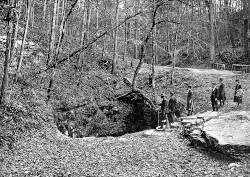

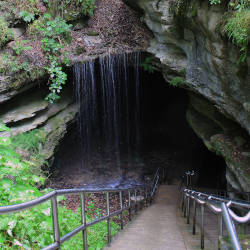




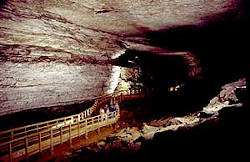
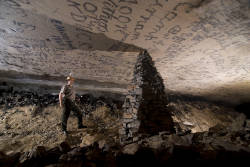
| Location: |
Navi: 1 Visitor Center Parkway. Mammoth Cave, KY 42259-0007.
Highways I-65, 31W, 31E from the North. Blue Grass Parkway, the Cumberland parkway, and U.S. 68 from the East. I-65, 31W, and U.S. 68 from the South. U.S. 231, The Green River parkway, and the Western Kentucky Parkway from the West. All connect with Ky. 70 and Ky. 255 to the park. (37.186292, -86.100264) |
| Open: |
Visitor Center:
APR to mid-AUG daily 8-18:30. Mid-AUG to OCT daily 8-18. NOV to MAR daily 8:30-16:30. Closed 25-DEC. [2021] |
| Fee: |
Broadway Tour: Adults USD 10, Children (6-12) USD 13, Pass Holder USD 9. Cleaveland Avenue Tour: Adults USD 22, Children (6-12) USD 16, Pass Holder USD 11. Discovery Tour: Adults USD 8, Children (6-12) USD 6, Pass Holder USD 4. Domes & Dripstones Tour: Adults USD 21, Children (6-12) USD 16, Pass Holder USD 10.50. Extended Historic Tour: Adults USD 23, Children (6-12) USD 17, Pass Holder USD 11.50. Focus on Frozen Niagara Tour: Adults USD 16, Children (6-12) USD 12, Pass Holder USD 8. Frozen Niagara Tour: Adults USD 18, Children (6-12) USD 14, Pass Holder USD 9. Gothic Avenue Tour: Adults USD 19, Children (6-12) USD 15, Pass Holder USD 8. Grand Avenue Tour: Adults USD 35, Children (6-12) USD 27, Pass Holder USD 17.50. Great Onyx Lantern Tour: Adults USD 23, Children (6-12) USD 18, Pass Holder USD 11.50. Historic Tour: Adults USD 20, Children (6-12) USD 15, Pass Holder USD 10. Introduction to Caving: Adults USD 35, Children (10-18) USD 28, Pass Holder USD 17.50. Mammoth Cave Access Tour Adults USD 22, Children (6-12) USD 16, Pass Holder USD 11. Mammoth Passage Tour: Adults USD 11, Children (6-12) USD 9, Pass Holder USD 5.50. River Styx Tour: Adults USD 22, Children (6-12) USD 16, Pass Holder USD 11. Star Chamber Lantern Tour: Adults USD 25, Children (6-12) USD 20, Pass Holder USD 12.50. Trog Tour: Children (8-12) USD 25. Violet City Lantern Tour: Adults USD 25, Children (6-12) USD 20, Pass Holder USD 12.50. Wild Cave Tour: Adults (16-) USD 66, Pass Holder USD 33. Wondering Woods Tour: Adults USD 18, Children (6-12) USD 14, Pass Holder USD 9. Senior discounts to holders of a valid Golden Age/Golden Access and America The Beautiful Senior/Access Pass. [2021] |
| Classification: |
 Karst Cave Karst Cave
 river cave. river cave.
|
| Light: |
 Incandescent Incandescent
|
| Dimension: |
The longest cave in the world: L=571,195 m, D=115m Mammoth Dome: H=58 m, Bottomless Pit: H=32 m. |
| Guided tours: |
Focus on Mammoth Photo Tour: L=400 m, D=120 min, VR=17 m, St=13 (+98 optional). Frozen Niagara Tour: L=1,200 m, D=120 min, VR=85 m, St=500. Grand Avenue Tour: L=6,500 m, D=4.5 h, VR=100 m, St=670. Great Onyx Lantern Tour: L=1,600 m, D=135 min, VR=10 m, St=40. Historic Tour: L=3,200 m, D=120 min, VR=100 m, St=440. Introduction to Caving: L=2,000 m, D=3.5 h, VR=85 m, St=280. Mammoth Cave Discovery Tour (Ranger-Guided): L=400 m, D=90 min, VR=40 m, St=180. Mammoth Cave Discovery Tour (Self-Guided): L=400 m, D=30 min, VR=40 m, St=180. River Styx Cave Tour: L=4,000 m, D=150 min, VR=120 m, St=560. Star Chamber Tour: L=2,400 m, D=135 min, VR=55 m, St=200. Travertine Tour: L=400 m, D=75 min, VR=14 m, St=13 (+98 optional). Trog Tour: L=1,600 m, D=150 min, VR=54 m. Violet City Lantern Tour: L=4,800 m, D=3 h, VR=57 m, St=160. Wild Cave Tour: L=9 km, D=6.5 h, VR=100 m. V=403,000/a [2009] [2021] |
| Photography: | allowed, no flash, no tripod |
| Accessibility: | no |
| Bibliography: |
Richard A. Waston, Richard A. Watson, Roger W. Brucker (1987):
The Longest Cave,
paperback, 331 pp, Southern Illinois University Press, February 1987, ISBN: 0809313227.
 amazon.com amazon.com
Joy M. Lyons (1991): Mammoth Cave - The Story Behind the Scenery, paperback, 48 pp, Kc Publishing May 1991, ISBN: 0887140505.  amazon.com amazon.com
James D. Borden, Roger W. Brucker (2000): Beyond Mammoth Cave - A Tale of Obsession in the World’s Longest Cave, hardcover, 353 pp, Southern Illinois University Press, November 2000, ISBN: 0809323451.  amazon.com amazon.com
Collen O’Connor Olson and Charles Hanion (2002): Scary Stories Of Mammoth Cave, 92 pp illus., SB $7.95. Both authors are guides at Mammoth Cave in Kentucky, USA. Over the years they have collected together a lot of amusing stories. Not recommended for bedtime reading. Patricia H Quinlan (2004): Beneath Their Feet, 373 pp, paperback, iUniverse, ISBN: 0595310133.  amazon.com amazon.com
A Novel about Mammoth Cave and its people. Pat lived at Mammoth Cave for seven years. Her husband was the caves historian/researcher. Using his archives she has written a historical novel which is very close to the truth. She uses the names of real people to describe events that actually happened at Mammoth Cave 150 years ago. Jeanne K Hanson (2007): Caves, 142 pp, 16 colour and 30 B&W photos. Chelsea House, New York. pp 7-22 Cecil E. Goode (1986): World Wonder Saved - How Mammoth Cave Became A National Park, Mammoth Cave, KY: The Mammoth Cave National Park Assocation, 1986. |
| Address: | Mammoth Cave National Park, P.O. Box 7, Mammoth Cave, KY 42259, Tel: +1-270-758-2180. |
| As far as we know this information was accurate when it was published (see years in brackets), but may have changed since then. Please check rates and details directly with the companies in question if you need more recent info. |
|
History
| 4,000 BP | Ancient artifacts and well-preserved human mummies found in Mammoth indicate that people began venturing into the cave. |
| 1790 | John Houchin moves from Virginia and settles on the Green River near the cave, discovers the cave according to legend. |
| 1792 | John Houchin makes gunpowder from “nitre” found in cave dirt. |
| 1798 | first written mention: Valentine Simons buys 200 acres of land containing two saltpeter caves. |
| 1799 | Sold to John Flatt, larger cave becomes known as Flatt’s Cave. |
| 1808 | Flatt’s Cave sold by McLean brothers to Fleming Gatewood and Charles Wilkins. |
| 1810 | first published use of the name Mammoth Cave, in a Richmond, VA, newspaper. |
| 1812 | Fleming Gatewood sells his interest in Mammoth Cave to Hyman Gratz of Philadelphia. |
| 1813 | The mummy Fawn Hoof is found in Short Cave and taken to Mammoth Cave for display to visitors. |
| 1813-1815 | slaves mine vast amounts of saltpeter, sent to gunpowder factories in the east for the War of 1812. |
| 1815 | Nahum Ward draws a new cave map and writes a long description of the cave and mummy, which makes Mammoth Cave famous. |
| 1816 | first known formal cave tour. |
| 1834 | George S. Gatewood holds religious services in the cave, chamber named Methodist Church. |
| 1835 | first survey and map showing eight miles of cave by Edmund F. Lee. |
| 1838 | Franklin Gorin and A.A. Harvey purchase Mammoth Cave and 1,600 acres from Hyman and Simon Gratz. |
| 1838 | the slave Stephen Bishop becomes a cave guide. |
| 1839 | Dr John Croghan buys the cave from Franklin Gorin. |
| 1842 | new map by Stephen Bishop. |
| 1842 | first description of blind fish in River Styx described in an article published in Philadelphia. |
| 1842-1843 | Dr John Croghan tests speleotherapy with 10 tuberculosis patients, the experiment shows that cave air does not cure tuberculosis. |
| 1844 | Alexander C. Bullitt visits Mammoth Cave and writes  Rambles in the Mammoth Cave. Rambles in the Mammoth Cave. |
| 1845 | renowned Norwegian violinist Ole Bull plays his violin in a cave chamber today known as Ole Bull’s Concert Hall. |
| 1849 | after the death of Dr John Croghan, Mammoth Cave is placed in a trust, named the Mammoth Cave Estate. |
| JUN-1850 | Ralph Waldo Emerson visits Mammoth Cave seeing the "night sky" in Star Chamber, later he writes an essay titled “Illusions”. |
| APR-1851 | opera diva Jenny Lind visits the cave, but rumours that she was singing in the cave were not true. |
| 21-AUG-1861 | Civil War skirmish between the Mammoth Cave Home Guard and rebel partisans 800 m from the Historic Entrance. |
| 1866 | first photographs taken in Mammoth Cave by Charles Waldack, a Belgian photographer who emigrated to Cincinnati, are the second oldest cave photograph existing. |
| 1870 | Ralph Seymour Thompson publishes The Sucker’s Visit to the Mammoth Cave. |
| 1876 | Dr. Horace Carter Hovey visits the cave. |
| 1876 | Shakespear actor Edwin Booth visits the cave and recites a soliloquy from Hamlet at Booth’s Amphitheater. |
| 1881 | mushroom farm between Bunker Hill and Olive’s Bower. |
| 1897 | Horace Carter Hovey and Richard Ellsworth Call publish the first edition of The Mammoth Cave of Kentucky. |
| 1908 | German engineer Max Kämper creates a map of Mammoth Cave for the Mammoth Cave Estate and discovers now parts of the cave. |
| 1916 | Edmund Turner and L.P. Edwards discover Great Onyx Cave. |
| 1917 | first electric lights installed in Cleaveland Avenue. |
| 1920 | George Morrison forms the Mammoth Cave Development Company and blasts the New Entrance to Mammoth Cave with 20 sticks of dynamite. |
| 1924 | Mammoth Cave National Park Association formed. |
| 1925 |  Delco-Light Plant provides the first electric lights for the Frozen Niagara section. Delco-Light Plant provides the first electric lights for the Frozen Niagara section. |
| 1933-1942 | major projects by the Civilian Conservation Corps (CCC). |
| 1935 | mummy of an Red Indian dubbed Lost John, who died around 17 BC, discovered 3 km from the entrance by guides Grover Campbell and Lyman Cutliff. |
| 01-JUL-1941 | Mammoth Cave National Park established to preserve the cave. |
| 1981 | designated a World Heritage Site. |
| 1990 | UNESCO classified it as an International Biosphere Reserve. |
| MAR-2007 | new electric light for six million dollars. |
Description
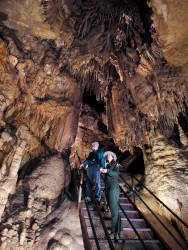
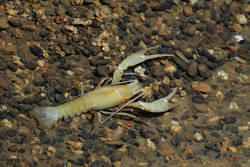



Mammoth Cave is the longest cave of the world with more 570 kilometers of passages. This length is so extraordinary, the second largest cave of the world is the Jewel Cave, South Dakota, U.S.A., which is "only" 218 km long. And although it is very unlikely the length of Mammoth Cave will be reached in the next future by any other cave, place two is still changing now and then because of new discoveries. And its length is not the only superlative, its light system was renovated in 2006 for USD 6 Million. The result was an electrical system with 1,200 light fixtures, 73 km of wiring and 47 phones for 9.6 km of cave trails.
The Mammoth Cave system is so huge, it extends over two mountain ranges. Once the cave systems in both mountains were explored separately, until the connection between both was found in the 1960s. The second cave, Flint Ridge was nearly as big as Mammoth Cave. The formal name of the whole system is Mammoth-Cave-Flint-Ridge-System, but as this name is rather long it is simply called Mammoth Cave.
Several entrances of the cave system were separately developed for tourists. Some of them were not known to be the same cave, so they have their own names. They were named Short Cave, Salts Cave, Long Cave, Colossal Cave, Bedquilt cave, Unknown Cave, Great Onyx Cave, Great Crystal Cave, Crystal Cave, Sand Cave, or Collins Crystal Cave. Some show caves are closed now or only visited on so-called historic cave tours. Being the biggest, most important and best developed Cave Park in the World, there are numerous different tours of all lengths, durations, and physical conditions. Rather new is a photography tour, which is much appreciated by amateur cave photographers.
Mammoth Cave is one of the earliest tourist attraction in the United States. It was first promoted in 1816, second after Niagara Falls, New York. In other words, it is the first show cave in the U.S.A. open to the public. Many people owned the land and the caves since the early 19th century, most of them were farmers, which actually owned the land, which accidentally had caves. Some were mining saltpeter from the cave, especially for the War of 1812 and the Civil War. And notable is Dr John Croghan who owned the cave from 1839 to his death in 1849. He tried to help tuberculosis patients and first built two huts in Audubon Avenue for them. A year later tuberculosis patient Dr. William J. Mitchell and nine others move to Mammoth Cave. This is the only test of speleotherapy with tuberculosis patients. After a year some had died in the cave and not one has become better, the experiment shows that cave air does not cure tuberculosis.
Probably the most famous guide and cave explorer of Mammoth cave is Stephen Bishop (-1857). He discovered miles of passages, underground rivers, and gypsum-decorated chambers. He became a cave guide in 1838 after Franklin Gorin purchased the cave. But he was intelligent and he listened to the academic visitors when they explained something. He was described as
“a self-educated man...
He had a fine genius, a great fund of wit and humor, some little knowledge of Latin and Greek, and much knowledge of geology, but his great talent was his knowledge of man…
His talents were of the first order.
He was trustworthy and reliable; he was companionable; he was a hero and he could be a clown.
He knew a gentleman or a lady as if by instinct.
He learned whatever he wished to learn without trouble or labor, and professors of geology spoke highly of his knowledge in that department of science.”
Franklin Gorin
Bishop discovered the Mammoth Dome and the Ruins of Karnak, he was the first who crossed the Bottomless Pit on a guided tour with a visitor and thus extended the cave by miles.
In 1942 on a visit at Dr John Croghan’s house he drew a map of the explored passageways of the cave from memory.
This map was published in the book
 Rambles in the Mammoth Cave.
He was a popular guide and was often requested by tourists, he was "...almost as widely known as the Cave itself.”
But like many guides at that time he was a slave.
He gained his freedom in 1856 and continued working at Mammoth Cave as a guide, but now paid.
He died in JUL-1857 and was buried in an unmarked grave in a small cemetery that Dr. Croghan had established for some of his deceased patients.
It was later named the Old Guide’s Cemetery in honor of many cave guides who were buried here.
Rambles in the Mammoth Cave.
He was a popular guide and was often requested by tourists, he was "...almost as widely known as the Cave itself.”
But like many guides at that time he was a slave.
He gained his freedom in 1856 and continued working at Mammoth Cave as a guide, but now paid.
He died in JUL-1857 and was buried in an unmarked grave in a small cemetery that Dr. Croghan had established for some of his deceased patients.
It was later named the Old Guide’s Cemetery in honor of many cave guides who were buried here.
- On showcaves.com
 Subterranean World Heritage List
Subterranean World Heritage List Guiness World (Cave) Records
Guiness World (Cave) Records Crater Names on Asteroid Ida
Crater Names on Asteroid Ida Historic Descriptions of the Mammoth Cave
Historic Descriptions of the Mammoth Cave
 Search DuckDuckGo for "Mammoth Cave National Park"
Search DuckDuckGo for "Mammoth Cave National Park" Google Earth Placemark
Google Earth Placemark Mammoth Cave National Park - Wikipedia (visited: 29-APR-2021)
Mammoth Cave National Park - Wikipedia (visited: 29-APR-2021) Index
Index Topics
Topics Hierarchical
Hierarchical Countries
Countries Maps
Maps